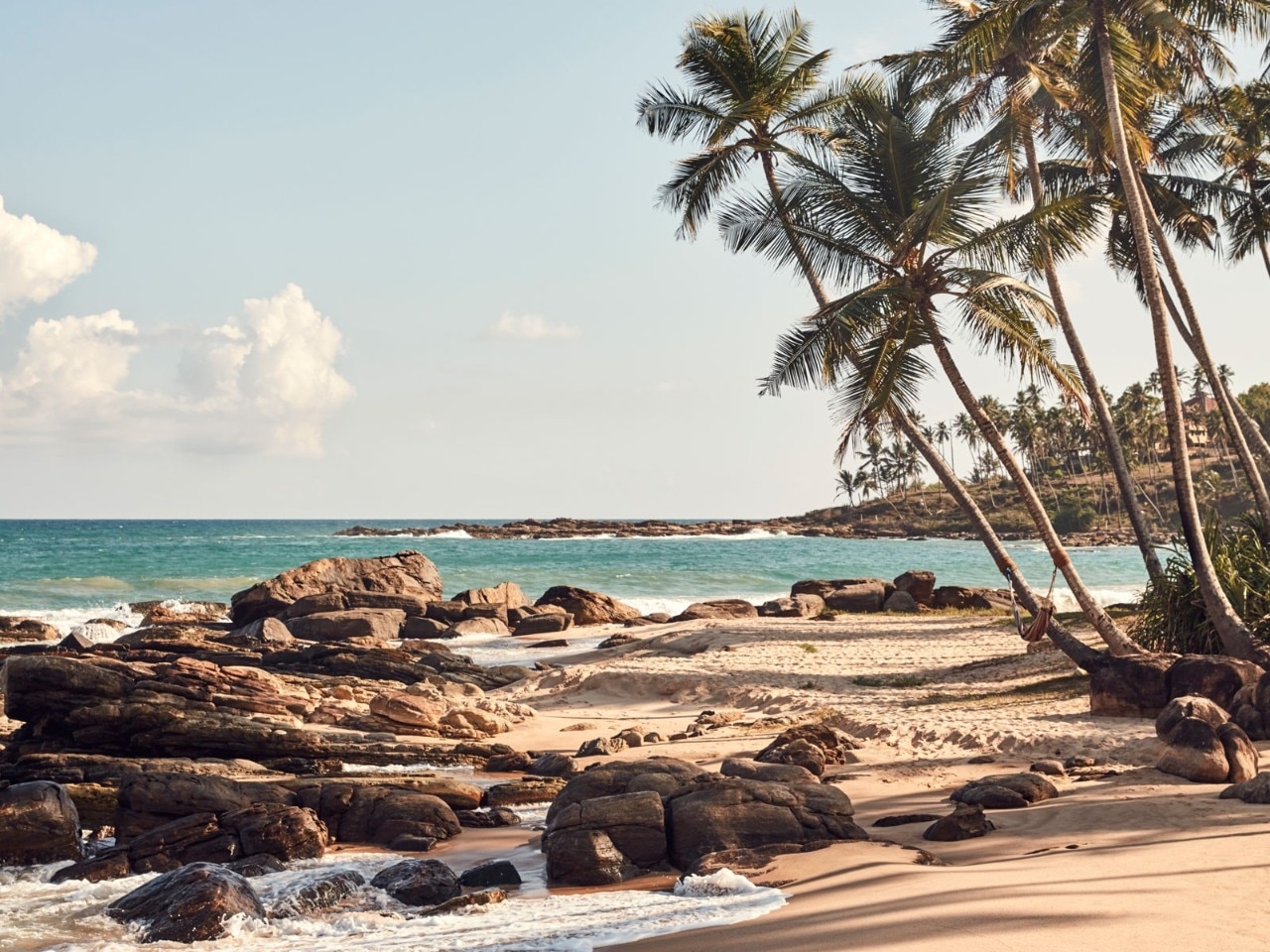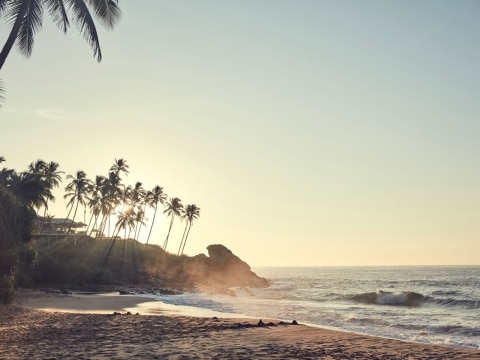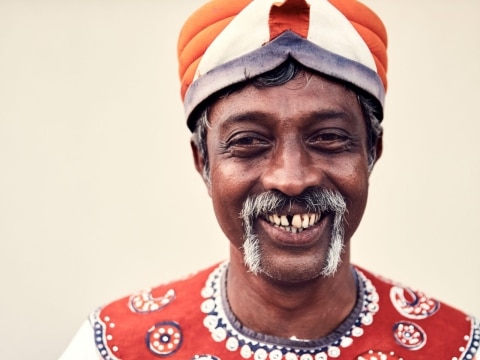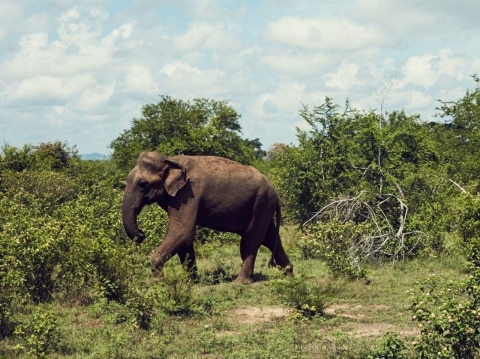Explore Sri Lanka’s Serene South Coast

Delight in the calm that's descended on this island nation.
Few days into my visit to Sri Lanka, I notice that I am describing everything as “a delight”. The little honey cakes that celebrate the Buddhist and Hindu New Year are a delight, as is my breakfast of prawn curry accompanied by rice boiled in milk. A refreshing cold towel spritzed in lemongrass oil is merely delightful but fresh tamarind scooped out of pods from the tree growing by the roadside is most definitely a delight. It’s a recent affectation and it makes me sound like Nigella Lawson cooing over a chocolate lava cake. In my defence, however, it’s very difficult to describe Sri Lanka any other way.

Famed for its beauty and fertility, Sri Lanka has been romanticised by travellers as a utopian paradise since Roman times. In the past few decades, however, it seemed it couldn’t catch a break. Starting in the early 1980s, a civil war between government forces and the Tamil Tigers separatist movement ravaged the island, killing tens of thousands. Then, in 2004, with the end of hostilities seemingly in sight, the Boxing Day tsunami hit and left a staggering 35,000 people dead and missing. A relatively brief but extremely vicious round of fighting followed until finally, in 2009, the Tamil Tigers admitted defeat and the conflict was declared over.
SEE ALSO: 5 Great Colombo Hotels
Since that time, spurred by infrastructure investment and the rebuilding of tsunami-devastated communities, Sri Lankan tourism has boomed, especially along the country’s south-east coast. Perhaps nowhere better exemplifies this rapid transformation than the town of Tangalle.
About 200 kilometres from Colombo, the commercial capital, Tangalle is a fishing community of the sort familiar to anyone who was backpacking in Thailand or Bali a few decades ago; the kind of place where you can enjoy a beer and a lobster dinner under a thatched umbrella on the beach and where the fanciest shop in town is called Rohan’s Highly Fashionable Accessories.
In recent years, chic boutique properties have opened to complement the backpacker lodgings and beach cabins. Maya villa and Coco Tangalla, for instance, offer restored Colonial elegance and signature restaurants devoted to Sri Lanka’s superb seafood. But the boldest statement of confidence in the region’s potential as a travel magnet must surely be the Anantara Peace Haven Tangalle Resort.

Find a room
Located just outside Tangalle proper but not so far as to make visitors feel isolated, Anantara is built on a former coconut plantation fronting a pristine palm-fringed beach. With spacious rooms and private villas, a double-decker infinity pool, a variety of restaurants and a spa supervised by a practitioner of Ayurvedic medicine, it manages the rare feat of having all the trappings of a generic luxury resort without feeling like one.
Little details make the difference. On arrival I’m handed a cup of coconut milk harvested by an elderly but alarmingly agile man employed for the sole purpose of shimmying up palm trees to fetch coconuts for guests. As I wait for my room key, I sip and watch a concert performed by three girls singing to the gentle beating of the banku rabana communal drum. Every night a conch blasts to mark the setting of the sun.
In 1800, Anglican priest James Cordiner noted, “The inhabitants of this place are uncommonly obliging”, an observation that remains true of Sri Lanka today. Indeed, the seeming genuineness of the welcome – not just at Anantara but all over the island – is almost startling. As a cynical travel writer, I’m accustomed to the reflexive have-a-nice-days or sawadikas (hellos) of the international hotel circuit and I’m taken aback by this deeply felt spirit of hospitality. I don’t expect sincerity from a waiter or bellboy but when it happens, I savour it.

New visitors to Sri Lanka with experience of India might expect the island to share some of the character of its giant neighbour. But it doesn’t really. Sri Lanka’s placidness is the polar opposite of the Indian subcontinent’s frantic, almost demented exuberance. This apparent serenity is only enhanced by the overwhelming fecundity of the landscape.
Although my visit coincides with the end of the dry season, the roadside is lined with flowers and fruit. Peacocks roost in the tops of palms like flamboyant angels in tropical Christmas trees. At Udawalawe National Park, elephant families wallow in mud or scratch against tree trunks only metres from our truck while deer and monkeys flit through the undergrowth. Even the manicured grounds of the resort can’t halt nature’s inevitable encroachments: geckos sun themselves on walls; hermit crabs march angrily up the path; a fat goanna-sized lizard jumps out of the hedgerow, alarming a family of Dutch tourists.

As beautiful as Sri Lanka’s landscape is, its culture is even more remarkable. Modern humans have occupied the island for at least 37,000 years and the arrival of Buddhism in the third century BC radically shaped the national character. Temples – ancient and modern, Buddhist and Hindu – are everywhere. They range from venerasble fifth-century structures such as the rock temples of Mulkirigala, about 30 minutes from Tangalle, to modern complexes flashing with LED displays like spiritual pinball machines.
Sri Lanka’s colonial and trading history has left a palpable mark, too. Echoes of European, Arab and even Chinese influences can be found in food, music, language and traditional costume. Perhaps there’s no greater illustration of this mingling of cultures than Galle, about an hour and 45 minutes’ drive west of Tangalle. This fort town was founded by the Portuguese then later occupied and built upon by the Dutch and the British. With its mix of striking Colonial architecture and indigenous culture, it recalls subcontinental gems like Pondicherry or Kochi, although it’s more cosmopolitan.
Galle Fort is the old centre of town. Touristy but not a tourist trap, it’s lively yet unhurried; alongside the art galleries, bars, teashops and restaurants, kids play cricket in the squares while Dutch churches host services as parishioners fan themselves with hymnbooks.

The shopping and dining scenes are sophisticated. Exhibition venues such as Hempel Galleries have fine contemporary works by local artists, while boutiques Souk 58 and Barefoot stock modern twists on traditional designs. A few stores offer the chance to contribute to the local community. Shoba sells a range of crafts made by economically disadvantaged women, many of them tsunami widows, while Embark’s playful T-shirts and accessories raise money to help the country’s street dogs.
As well as its Western colonial heritage, Galle is home to a large population of Sri Lankan Moors, the descendants of Arab traders. Mosques and saints’ tombs dot the area and stories of the time spent here by 14th-century Berber traveller Ibn Battuta are well known.
Like many of his Islamic contemporaries, Battuta believed Sri Lanka to be the place where Adam and Eve were forced to live after their expulsion from the Garden of Eden. Even allowing for its recent brutal past, it seems absurd that life in a place this lovely might ever have been a punishment. Paradise it may not be but Sri Lanka is, undeniably, a delight. 


